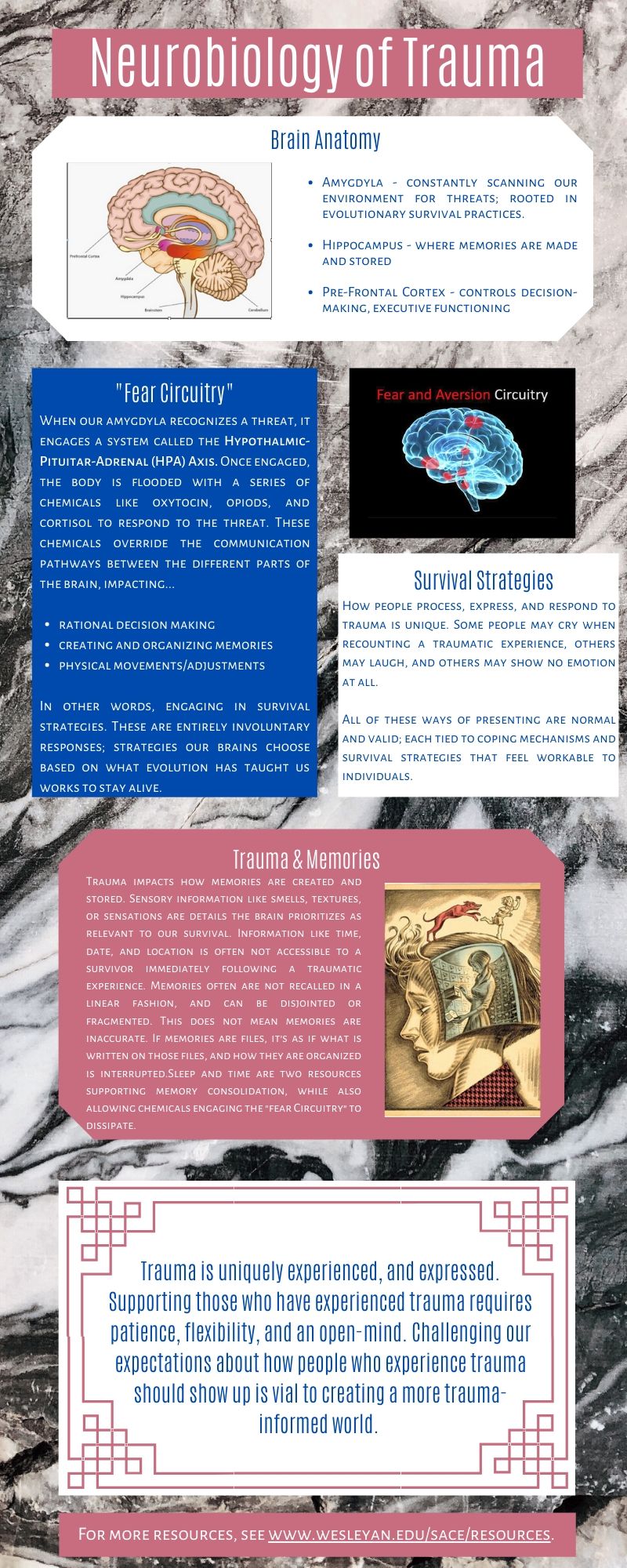Based on how trauma affects our brains and bodies, how a survivor recounts their narrative may not be exactly how we expect. For this reason, it’s important to think about the neurobiological impacts of trauma, and how this will inform how a survivor may share their narrative and connect to their experience.
Brain Anatomy
When thinking about the connections between neurobiology and trauma, there are a few particular aspects of the brain function worth highlighting.
The first, is the amygdala. This part of our brains is constantly scanning for threats to our survival. When it recognizes a threat, it communicates that information to the hippocampus and pre-frontal cortex (where your brain stores information, makes decisions, and hold memories). This is to train your body and brain to keep a record of what is dangerous, to keep you safe in the future. Trauma is interpreted by the amygdala as a threat to our survival, so our body goes into basal survival mode.
These chemicals are:
- Catecholamines (engaging our fight or flight response; these can be damaging to the hippocampus and impair memory consolidation)
- Cortisol: to give us energy
- Opioids: to prevent pain
- Oxytocin: promotes good feelings
These chemical reactions to trauma sometimes result in unexpected reactions embodied by survivors. (Thus explaining why everyone’s responses are different.)
“Fear Circuitry”
Part of that survival mode is the engagement of the Hypo-Pituitary-Adrenal (HPA) Axis (or “fear circuitry”). This is our brain’s attempt to balance our body and bring us back to equilibrium following traumatic events. Once engaged, the body is flooded with a series of chemicals like oxytocin, opiods, and cortisol to respond to the threat. These chemicals override the communication pathways between the different parts of the brain, impacting…
- rational decision making
- creating and organizing memories
- physical movements/adjustments
Survival Strategies
In other words, our body is engaging in survival strategies. These are entirely involuntary responses; strategies our brains choose based on what evolution has taught us works to stay alive.
This also applies to how survivors of trauma cope following an experience of harm. How people process, express, and respond to trauma is unique. Some people may cry when recounting a traumatic experience, others may laugh, and others may show no emotion at all.
All of these ways of presenting are normal and valid; each tied to coping mechanisms and survival strategies that feel workable to individuals.
Trauma & Memories
Trauma impacts how memories are created and stored. Sensory information like smells, textures, or sensations are details the brain prioritizes as relevant to our survival. Information like time, date, and location is often not accessible to a survivor immediately following a traumatic experience. Memories often are not recalled in a linear fashion, and can be disjointed or fragmented. This does not mean memories are inaccurate. If memories are files, it’s as if what is written on those files, and how they are organized is interrupted. Sleep and time are two resources supporting memory consolidation, while also allowing chemicals engaging the “fear circuitry” to dissipate.
Supporting Survivors of Trauma
Trauma is uniquely experienced, and expressed. Supporting those who have experienced trauma requires patience, flexibility, and an open-mind. Challenging our expectations about how people who experience trauma should show up is vial to creating a more trauma-informed world.
Vicarious Trauma
Supporting survivors is “heart-work” – it takes emotional energy that can be activating for us as well; sometimes manifesting as vicarious trauma.
Vicarious trauma is the response that comes from being in the presence of trauma and how our bodies and psyche react to the profound despair, rage and pain we witness. It often happens unconsciously over time. It may not seem overwhelming at first, but eventually your body will let you know that it is too much. Holding space for survivors’ narratives weighs on our hearts and settles into our bones often in ways we don’t expect.
To that end, self-care is critical in mitigating and healing through vicarious trauma. In order to provide this care and support effectively, and sustainably, we need to take time and space to practice acts of kindness for ourselves, and participate in restorative, rejuvenating activities.
For more resources, please see www.wesleyan.edu/sace/resources



